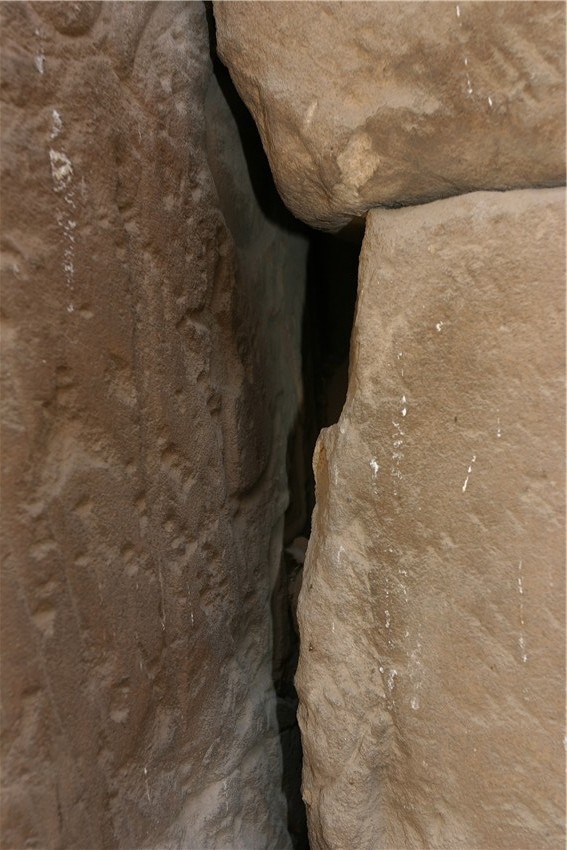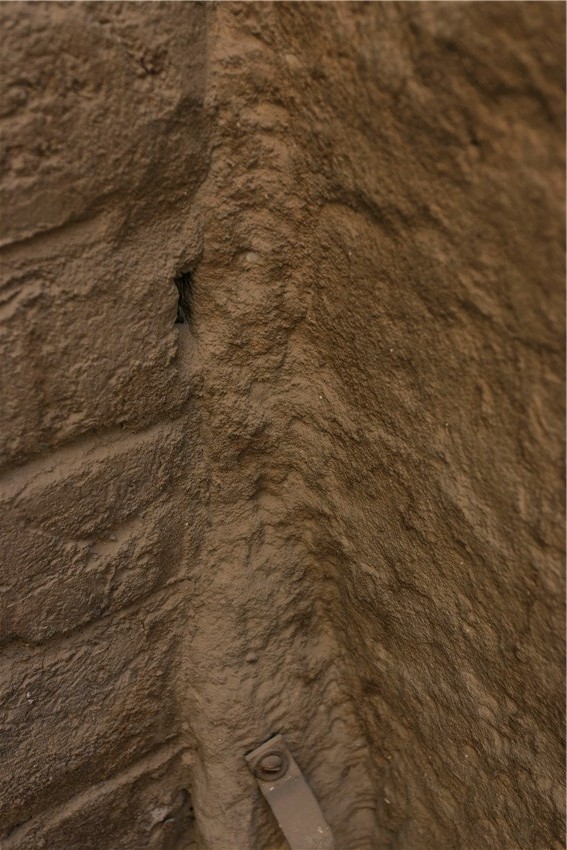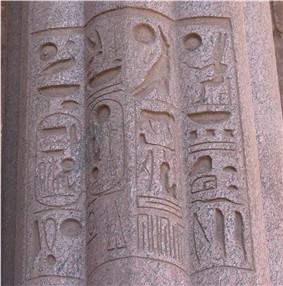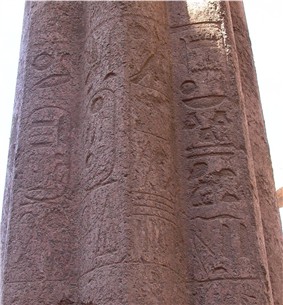|
Luxor-Temple |
last update:
12.04.2009
|
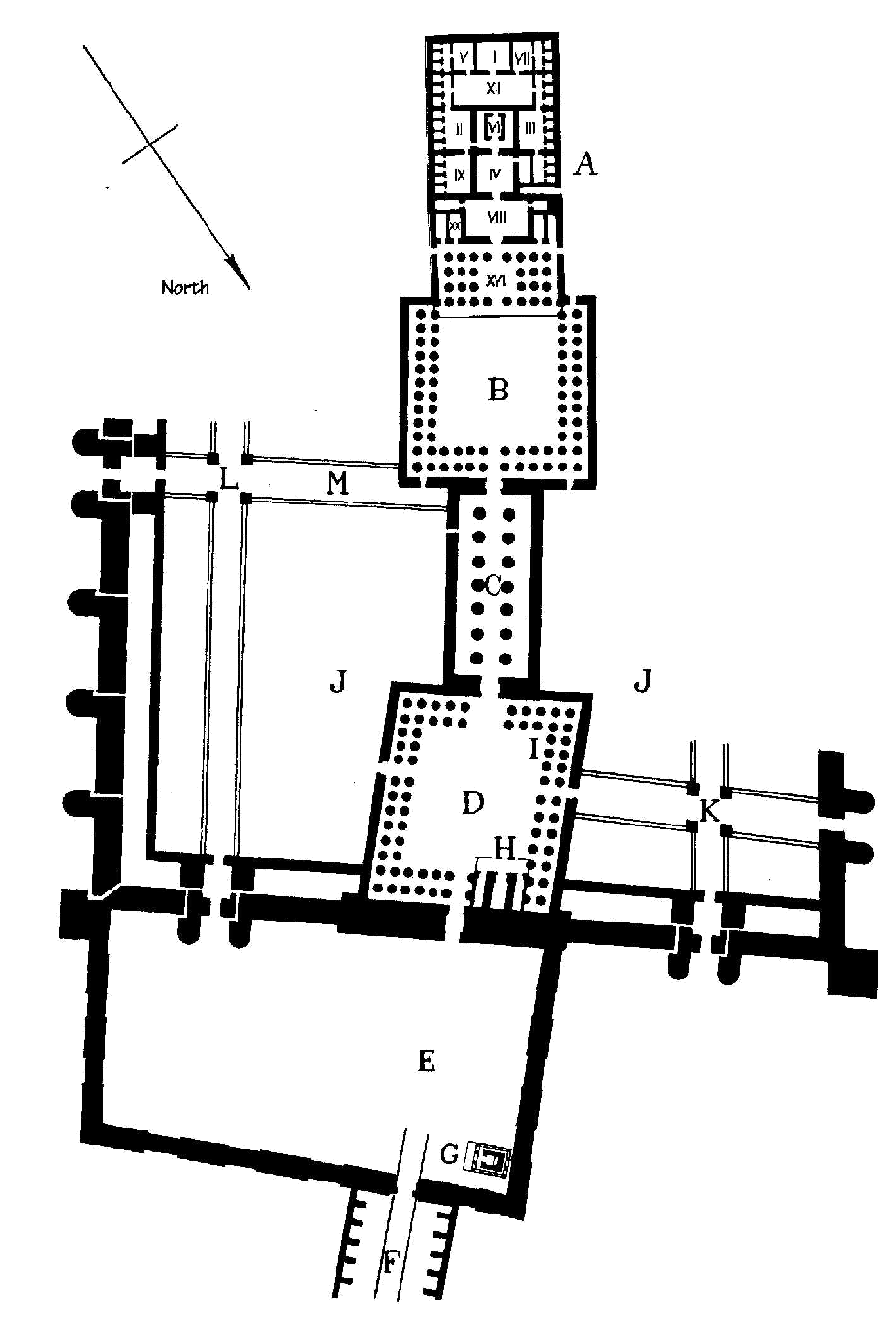
| Floor plan of Luxor-Temple (modified after Porter & Moss,
Vol.
II; Plan XXIX - XXXIIb) |
|
A |
Main Temple (Amenhotep III) |
|
B |
Peristyle (Sun Court of Amenhotep III) |
|
C |
Great Colonnade (Amenhotep III) |
|
D |
Court of Rameses II |
|
E |
Forecourt of Nectanebos |
|
F |
Avenue of human-headed sphinxes (Causeway to
Karnak Temple) |
|
G |
Small temple of Isis (Temple of Serapis) |
|
H |
Barque Shrine (originally raised by
Hatshepsut, usurped by Rameses II) |
|
I |
Bas relief showing several sons of Rameses II, on its left side another relief shows the front view of the pylon |
|
J |
roman fortress (includes the whole temple
district, the drawing shows only part of the fortifications and of the
inner courts) |
|
K |
causeway to the Nile (built by Rameses II
and adjusted directly to his temple, the Ramesseum) |
|
L-M |
several causeways |
|
I |
Sanctuary |
|
II |
Coronation Room |
|
III |
Hall of the Entrance to the Duat
(partially destroyed) |
|
IV |
Offering Vestibule |
|
V |
Sanctuary |
|
VI |
Barque shrine (the original one
was replaced with a new one built by Alexander the Great) |
|
VII |
Sanctuary |
|
VIII |
Chamber of the Divine King |
|
IX |
Birth Room (very damaged) |
|
XII |
Hall dedicated to the Journey of the Sun |
|
XX |
Barque Shrine for Mut (left of it there
is the Barque Shrine for Khons, on the opposite side of the
"Chamber of the Divine King",
VII, there is the Barque Shrine for Amun-Ra; on its right side there are the
remainders of a staircase to the roof) |
|
|
|
| Luxor temple (= Ip.t-rsj.t) belongs to the few Egyptian temples, which were built parallel to the
river Nile (the same alignment 'parallel to the Nile' is to be seen at
the temples of Mut and Month in eastern area of the district at Thebes
- all three open to the north, furthermore, the temple of Khons at
Karnak was
built parallel to the Nile, however, it opens to the south; among the
other temples of Egypt an adjustment parallel to the Nile is to be seen
at the temple of Horus of Edfu which opens to the south). |
| Starting with the central sanctuary in the southern part
of Luxor-temple the building was erected by Amenhotep III in three
phases and finally ended up with the Great Colonnade at the court of
Rameses II. Most likely, Amenhotep III could not finish the
temple, neither the monument nor the decoration. The decoration was finished probably in the course of the restoration of the after Amarna
period during the reign of the kings from Tutankhamun to Sethi I.
|
| Rameses II extended the temple by a courtyard, a pylon
and a new entrance which opens to a causeway leading to the Nile (due to the representation of the Opet
Festival in the Great Colonnade we know that - at the latest - since Tutankhamun
the procession from Karnak temple to Luxor temple and back took
the route on the Nile - therefore, already since that time there must
have been a connecting road to the Nile).
|
| The diagonal adjustment of the parts erected by Rameses II is
"self-explaining", these parts had been adjusted to causeway
to Karnak temple (see F in the plan above) - which originally met exactly the entrance at the northern gate to the
Great Colonnade built by Amenhotep III. If Rameses II had built
his courtyard and pylon straight on in front of the Great Colonnade,
then the causeway would have missed the entrance of the pylon ending up
"blind" at its walls.
|
Furthermore, Rameses II shifted the main entrance at the
side of the Nile as well as the causeway down to the river bank slightly in such a way that the new
entrance and the axis of the causeway (K) were exactly adjusted to his temple, the Ramesseum.
Accordingly, the decoration in the courtyard of Rameses II starts here at the western
gate and not at the entrance of the Pylon. Thus, the pylon built by
Rameses
II on the cause way to Karnak is to be interpreted only as "corresponding"
architectural element to the pylons at Karnak temple.
|
| All further extensions originate from later time - e.g. the
Avenue of Sphinxes (30th Dyn.). |
| With great certainty the part of Luxor-temple built by Amenhotep III was raised at the location of an older building
because during the reign of Hatshepsut the Luxor-temple was mentioned for the
first time as the destination of the Opet-feast. Most likely this older building had been erected before or during the reign of Hatshepsut
- perhaps already during the Middle Kingdom. - which afterwards was
completely dismantled by Amenhotep III. Up to now, no traces of a building that
might have been erected there by Hatshepsut were found. |
| However, inscriptions at the
Red
Chapel report that Hatshepsut had erected
totally 6 Way-Stations
(bark shrines) on the causeway from Karnak- to Luxor-Temple. Remains of the
first one are still to be seen near the entrance of the temple of Mut, resp.,
opposite to the temple of Kamutef. Most
likely, the 6th station had been erected near to the pylon of Luxor-temple
which afterwards had been usurped by Thutmosis III - according to Bell (1986)
the architrave of the middle chapel, dedicated to Amun, shows the full titles of
Thutmosis III. Later, Rameses II reused parts from an older bark shrine built by
Hatshepsut when he erected the triple bark shrine inside his
courtyard. |
| Rameses II. enlarged the temple by a court-yard including a
large pylon which were built diagonally in front of the temple and a new connection to the Nile (due to the representation of the Opet-feast in the
Great Colonnade
we know that at the latest since Tutankhamun the procession from Karnak temple to Luxor temple and back
took boats on the Nile - therefore, already at this time a connection to the Nile must have existed).
The diagonal extension of the Ramessid construction
explains itself by the course of the road approaching from Karnak temple (F) -
which originally exactly met the entrance of the temple at the northern gate leading to the Great Colonnade built by
Amenhotep III. If Rameses II had erected his court-yard and the pylon straight along the original axis of the temple,
then the entrance of the pylon would have been too far west - to the Nile -
while the road would have ended blindly in front of the eastern wing of the pylon.
|
| By his extensions Rameses II moved the main entrance to the side of the Nile and probably
built a road down the bank of the river (K) so that the new entrance and the axis of this
road exactly pointed to his mortuary temple on the west-bank, the Ramesseum. Accordingly, the decoration in
the court-yard starts here at the new entrance, the western gate, not at the gate of the pylon.
Thus, the pylon erected by Rameses II along the road to Karnak must be interpreted as only as corresponding
element to the pylons at the Karnak temple.
|
| All other extension date into later periods - as,
for example, the avenue of sphinxes (30th Dynasty). |
| Directly on the right side behind the entrance of the
pylon to the courtyard of Rameses II, there are three bark shrines
dedicated to the triad of Thebes, Amun, Mut and Khons, whose barques had stopped here during the
procession from Karnak to Luxor temple on the occasion of the Opet celebration. |
| The Triple Shrine was not part of the original plan of Rameses
II but it can be demonstrated by several architectural details on the last three
columns of the inner western row that the plan had been changed before the
rows of columns had been finished.
|
| The third last column of this row had been completely decorated
(see the following illustration). The decorated part of the column which was
oriented towards the courtyard shows Rameses II before the seated Amun-Ra and
below this scene an inscription with the name of Rameses II. However, parts of
the scene and of the inscription were later destroyed when the column was
hollowed to get room for the westernmost of the four columns made of
rose-granite which form the portico of the Triple Shrine. |
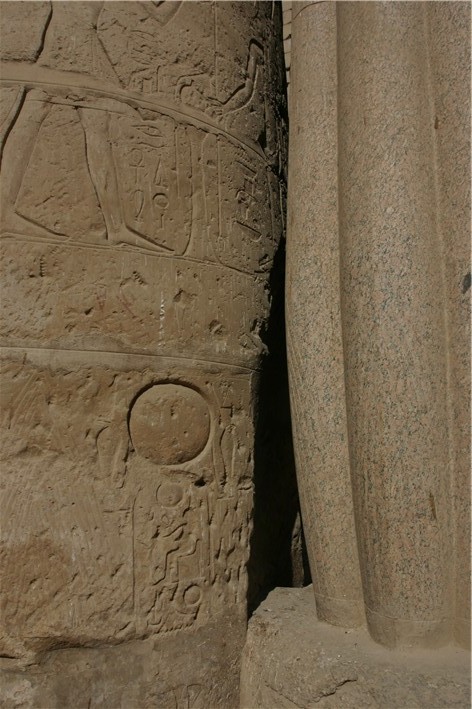
| The last but one column is already part of the west wall of the
Triple Shrine (i.e of the chapel the Mut). It was partly rounded and the workman
had already started with the lower part of the decoration (see down left
picture), but then the work was stopped and the column was integrated
into the wall (as shown by the photo of its rear part). |
| The last column got never finished (i.e. rounded) by the
workman because the column had been directly integrated into the west wall of
the Chapel of Mut. |
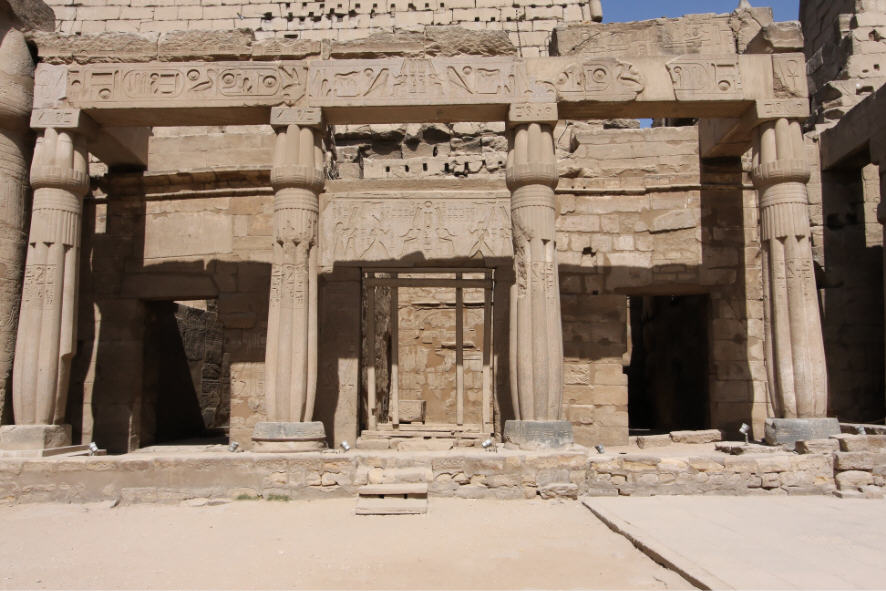
| "Triple bark shrine" dedicated to
(from left to right): Mut, Amun, Khons |
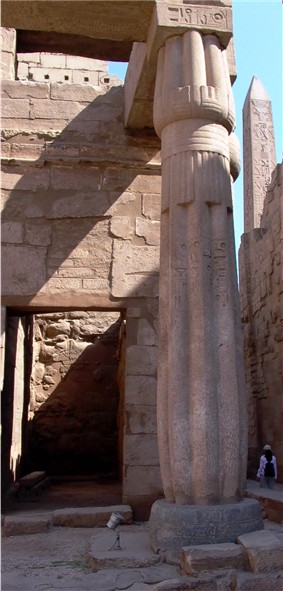 |
|
Probably during the extension of Luxor temple Rameses II erected the bark shrine
at the south wall of the western wing of the pylon whereby he reused some blocks and the columns
of red granite which were part of a way station built by Hatshepsut. Most likely
the original location of the Way-Station was not far
away from its position today. The columns with closed capitals of bundled papyrus
plants (the photo left shows the outer column in front of the Chapel of
Khons) should carry in primitive inscriptions the names of Hatshepsut (Bell, L.
D., 1986). Of particular interest is a sandstone block which today is still
lying on the
floor of the central chapel dedicated to Amun (see photo below). This block shows that names and surnames
of Amun-Ra, which had been inscribed on it before but were chiseled out in the Amarna
period and restored thereafter. This block was already published once 50
years ago, however, it was regarded to be a base of a statue. A rediscovered decoration fragment, which was
found under the floor of the Chapel of Mut, should be evaluated together with
it.
|
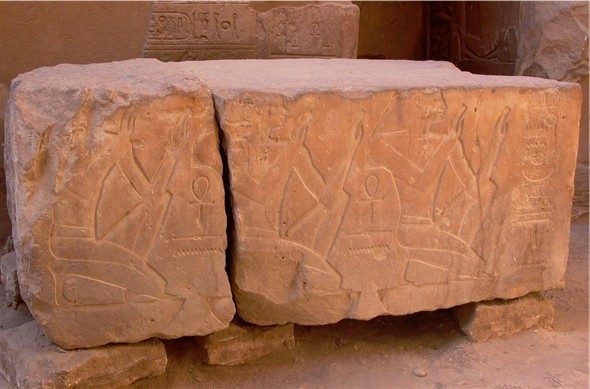
| The block shows a row of male figures kneeling on baskets.
These are "PaŽet"-people adoring Amun. This fragment was
part of the 6. Way-Station of Hatshepsut on the causeway to Luxor-Temple. Due to Bell (1998) the "PaŽet"-people were evidently
a more elite mythological component of the population, originally
perhaps members of the royal clan. |
The photos above show the inscription on the columns
of red granite. The left inscription was attached by Rameses II after he
had re-erected the bark shrines, therefore, the text is to be found on
the front side. The right inscription is to be seen on the rear side of
the right column which stands in front of the Chapel of Khons.
Both inscriptions show - with minor differences - in three registers
from left to right the titles of Rameses II (birth-, throne- and
Horus-name).
Of special interest is the 4. register, the text reads (with minor
differences in the way of writing) on the left photo:
"Jmn-Ra nb nswt
tAwj Hntj ipt=f mrj"
= Beloved by Amun-Ra, Lord of the Thrones of the Two Lands, First of his
Ipet"
On the right photo the end of the text shows the female form of
the "beloved of .." (mrj.t):
"Jmn-Ra nb nswt tAwj Hntj ipt=f mrj.t"
= Beloved by Amun-Ra, Lord of the Thrones of the Two Lands, First of his
Ipet"
The
cartouches demonstrate that the inscription had been usurped by Rameses II but originally the text addressed a female king - as testified by
lower
part of the right register (see also Habachi, 1965).
|
In addition to the aforementioned elements (architrave,
columns), a more exact inspection of the triple bark shrine recently brought to
light further 19 new fragments from the times of Hatshepsut, which had been reused in the upper masonry
of the chapels of Amun and Mut.
When Rameses II dismantled the bark shrine and reused the blocks in the chapels
they were turned by 90 degrees so that the original inscriptions were hidden inside the wall.
After that the undecorated sides of the blocks could be inscribed
by his own text. The discovered original inscriptions revealed that the female form
was used in the designation of the
ruler - this points to Hatshepsut.
|
|
The original decoration of the bark shrine consisted at least of 3 registers (the symmetry lets
assume a fourth register), on which kneeling people and several birds were
represented praising Amun-Ra. All were arranged around the symbol of the
unification of Upper and Lower Egypt. The mythological creatures, which are
shown here as "rekhyet"-birds and "PaŽet"-people, represent
the two aspects of the Egyptian population, whom one could roughly
translate - although the terms are not correct - with the more well-known
names "Plebs and Patricians" (Bell, L. D., 1986, 1998).
|
Furthermore, below the blocks showing the symbol of the
unification of Upper and Lower Egypt a list of "the nine bows", traditionally the
part of the earth controlled by the Pharaoh, is shown three times. These
are first
representations of "the nine bows" known to us and contain a
great surprise because the lists mention twice the "Shosu", a tribe
of Bedouins from south Palestine. The lists also
report
that the Egyptian rule on the country of the "Retenu" as well as on another
country (which unfortunately could not to be identified) had been
strengthened again.
Thus, these representations support
earlier speculations about military campaigns in Syria-Palestine during
the reign of Hatshepsut (Bell, L. D., ibid.).
|
| As already mentioned before, Rameses II erected the chapels
using original parts from a Way Station of Hatshepsut. However, he did not only reuse the blocks, he also must have modified
the plan, because all bark shrines built at the time of Hatshepsut
had probably been "passages" (e.g. the Red
Chapel), in which the barque with the statue of the god was
carried-in on one side and carried-out on the opposite side. The new chapels
built by Rameses II, however, are like "dead end streets".
|
| With regard to the rites this resulted in a "problem"
because the king could not do the offerings behind the god - or his
statue on the barque, respectively. This "problem" was solved in the Chapel of
Amun - and only in
this one, not in the
chapels of Mut and Khons - by a false door at the rear wall of the chapel
which "allows" the king at any time to step before the God in order to sacrifice. At the same time
two small niches were built into each side of the walls. Both niches
contained wooden statues of Rameses II, which likewise enabled him to
"walk" around the god while worshipping and making a sacrifice.
|
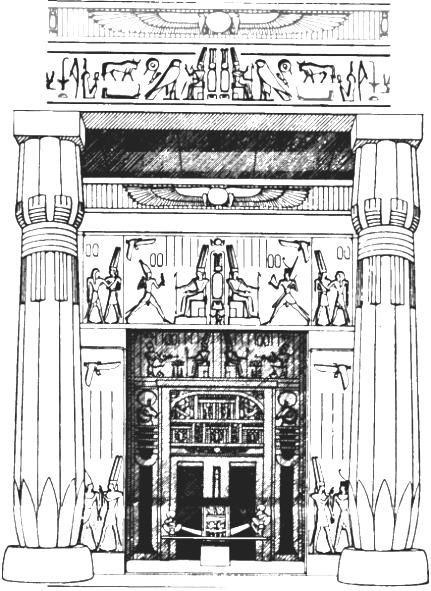
| Above a drawing of the Chapel of Amun by Schwaller de Lubicz (1998) - the drawing shows the frontal view with the two
adjacent columns, the entrance and the rear wall with the false door. The
false door is the rather rare type of a false door supported by central
pillar, on the right and on the left side of false door 2 "djed" columns with
ram heads and sun disks apparently carry the architrave over the false door. These
columns or staffs represent the Ka of the god!
|
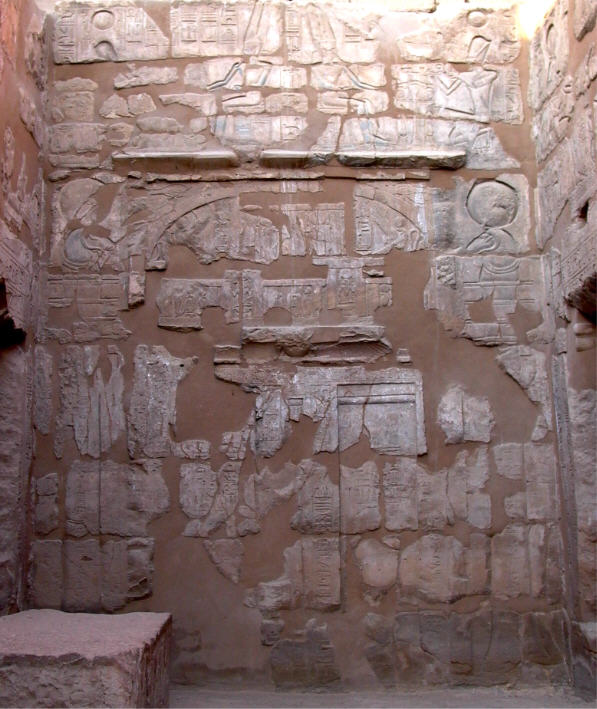
| The front view of the false door as it can be viewed today.
The 2 "djed" columns each crowned with a ram head and a sun
disk are quite easy to detect - anything else must be
guessed. On the left side of the chapel the aforementioned block showing
the "PaŽet"-people. |
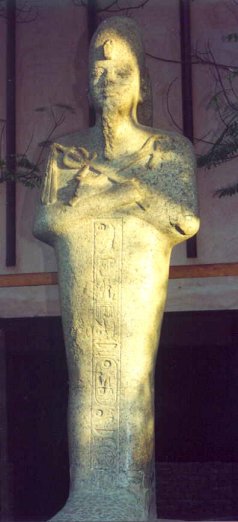 |
The finds in the bark shrines throw some new light on a granite statue
of an Osiride type (representation of the person as a deceased). Today,
this statue (left) is to be seen in the garden in front of the museum in Luxor.
This statue carries a cartouche of Rameses II. However, it probably represents
Hatshepsut. It is assumed that this statue originally had been erected in front the
bark shrines.
|
|


